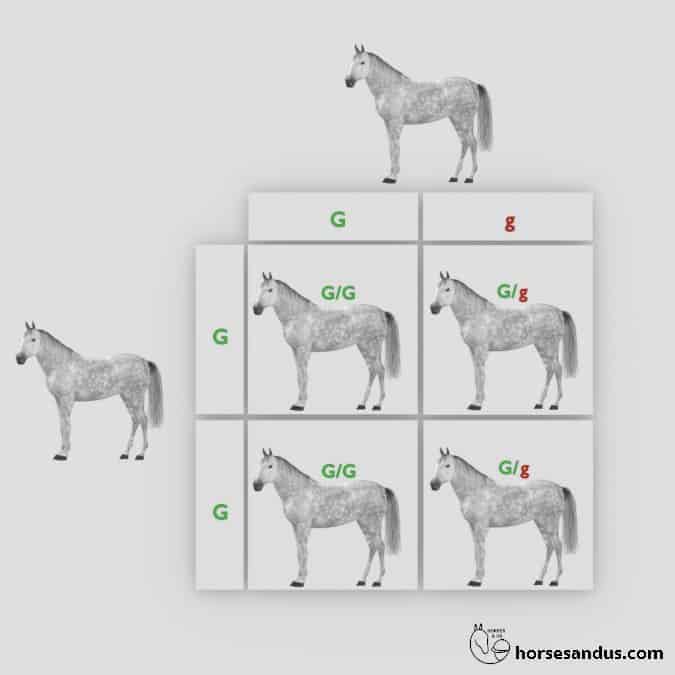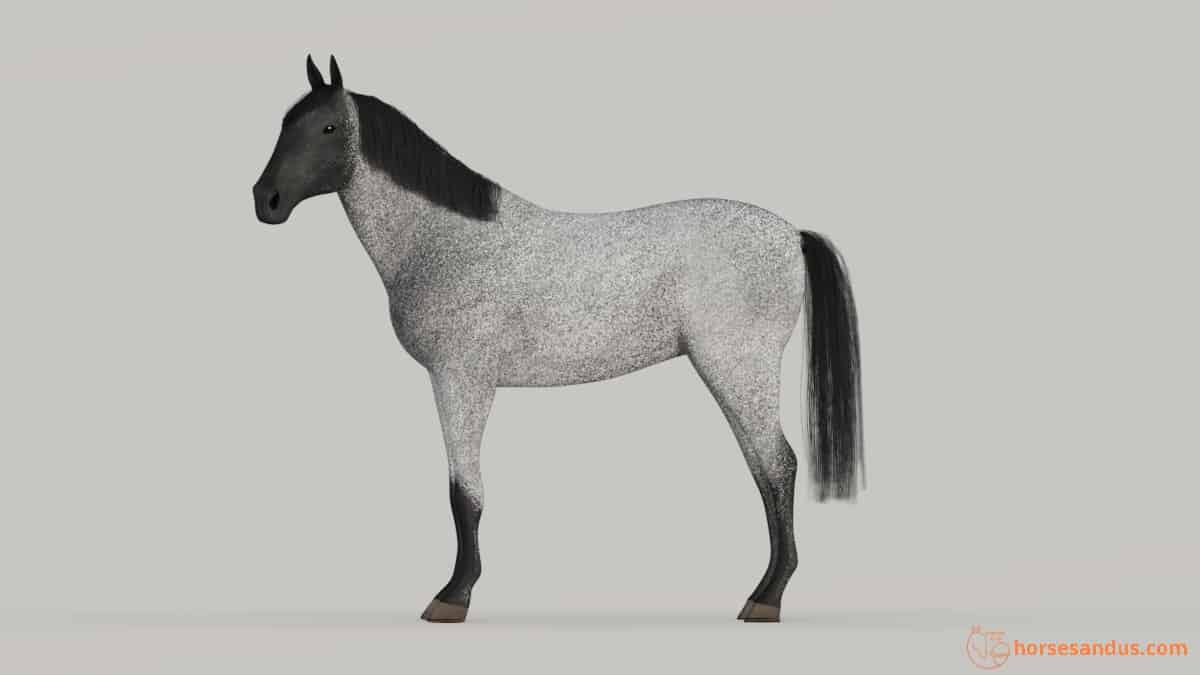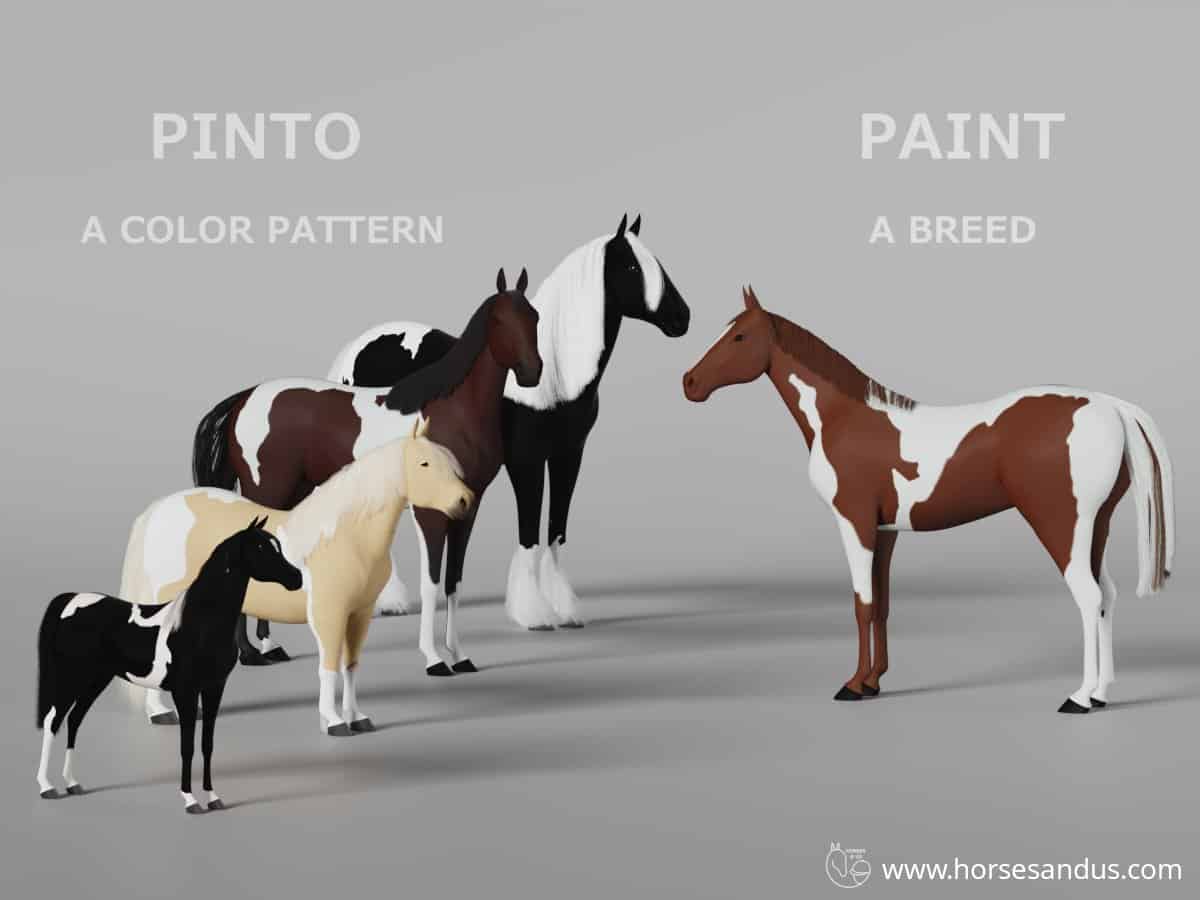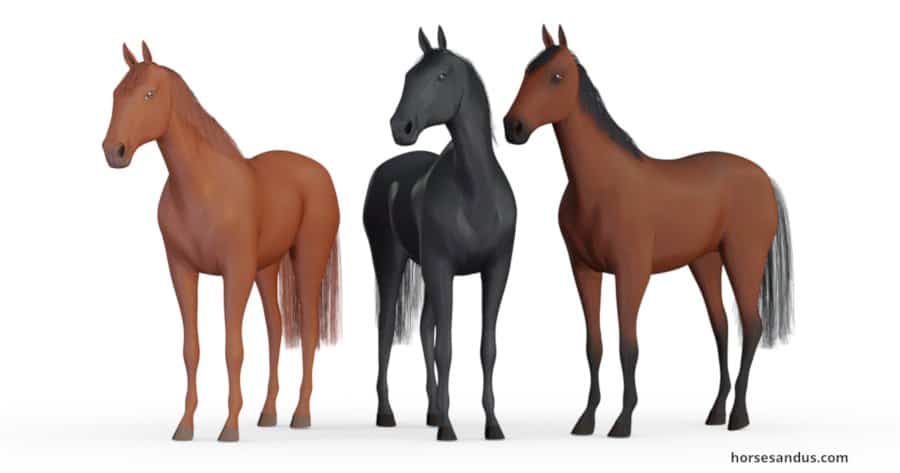Most famous white horses are actually greys with hair coats turned to fully white.
A Grey horse is born colored and goes through progressive hair depigmentation as it ages. This is similar to greying human hair, but in horses, it starts soon after birth and continues through different grey shades until the horse is completely white, usually around eight years old.
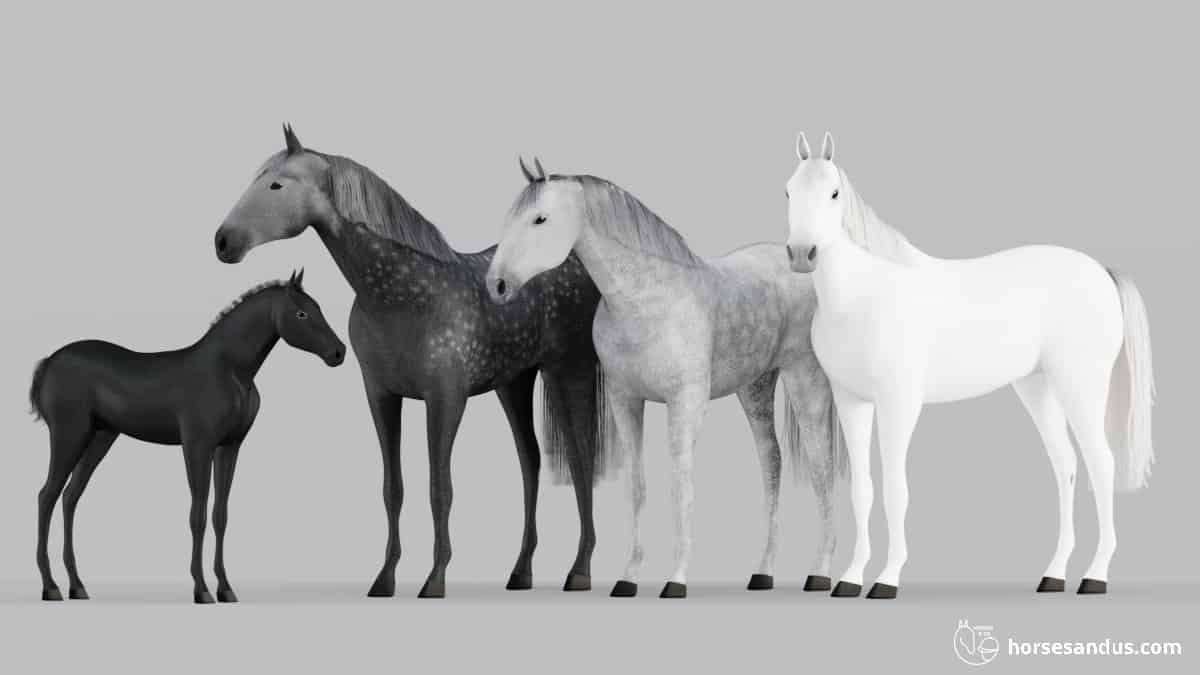
The speed of greying varies from horse to horse and also varies by breed. Some horses take a long time, with the greying process beginning as late as nine years old. Other horses are born with the greying process already begun.
There is a wide variety of horse coat colors and patterns. In this article, we will look at the shades and patterns produced by the grey gene.
Characteristics Of Grey Horses
Grey horses are sometimes confused with other horse colors. However, some unique characteristics can help you identify a grey horse.
Grey Horses Are Born Colored
Grey horses are born with colored coats like one of the base colors (Black, Bay, or Chestnut) or dilutions such as Dun, Cream, Silver, or Champagne.
But the action of the Grey gene will cause a gradual depigmentation of the hairs so that the coat will fade with time.
This faded look is a result of an intermix of white hairs with the base color hair.
Grey Horses Usually Have Dark Skin And Eyes
Unlike the hairs, the grey gene does not cause depigmentation of the skin or eyes. So grey horses will usually have dark skin and dark eyes.
If they happen to have pink skin or blue eyes, this will be due to the action of other genes like, for example, the cream gene.
However, some grey horses can go through a progressive depigmentation in the skin, called vitiligo. This results in pink-colored patches around the eyes, muzzle, and under the tail.
Grey Horses Go Through Different Shades Of Grey
During the intermediate steps of the greying process, the coat will change to different grey shades from darker to lighter, usually with dapples, until finally, the horse becomes completely white.
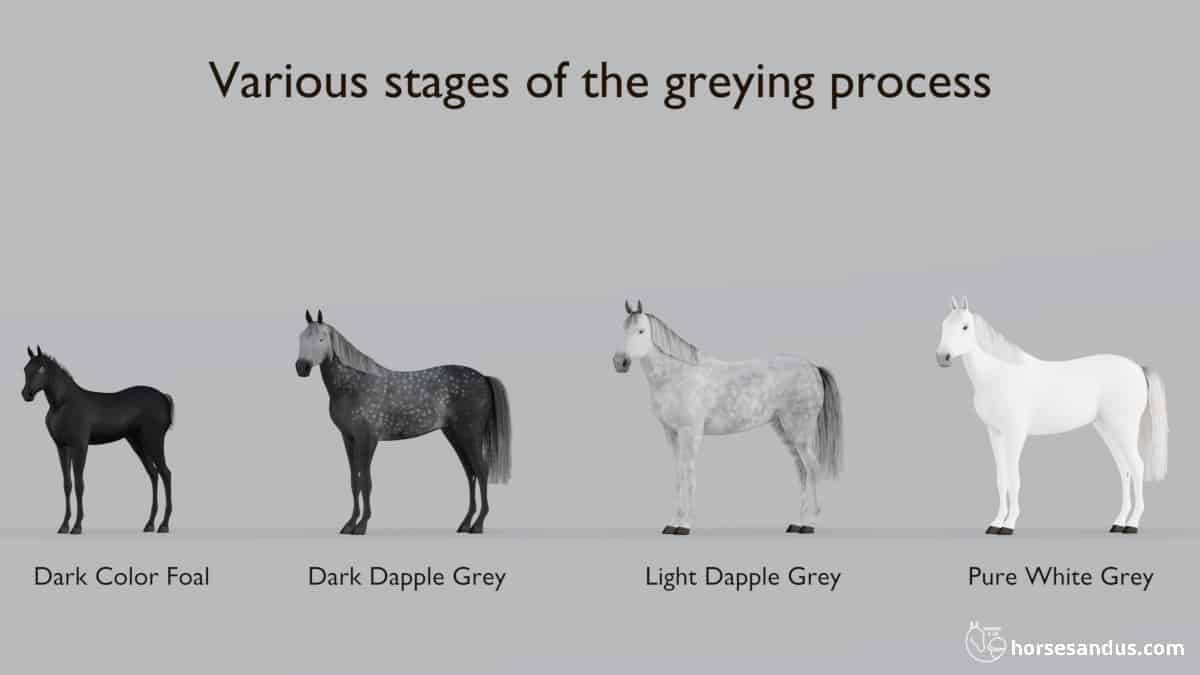
There Are Two Types Of Grey Horses
Not all grey horses become completely white. There are two types of grey horses.
One type goes through a depigmentation process in the mane and tail, so these become white. This type of horse becomes completely white with age.
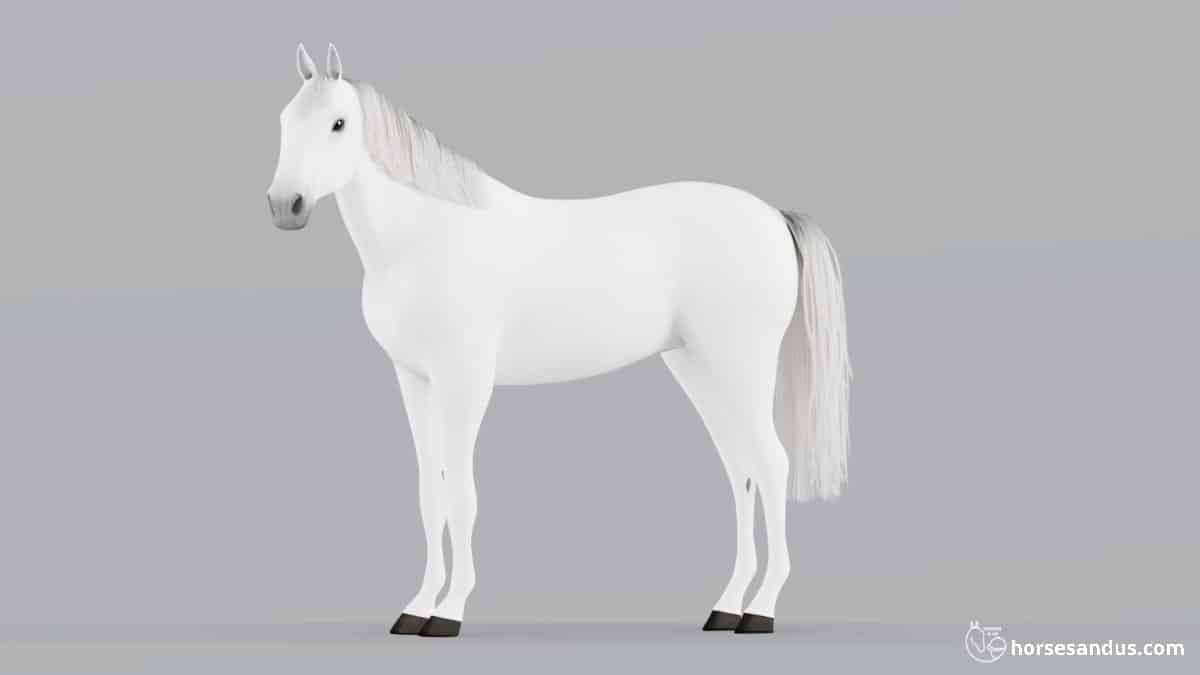
Another type tends to keep colored hair in the mane and tail and some areas of the body. This type of horse never becomes totally white.

Variations Of Grey Horse Coats
Grey horses manifest different grey shades and patterns, depending on the stage of the greying process and their coat’s base color.
Next, we will look at 6 variations of a grey coat, which have specific names to describe them.
1. Steel Grey
A Steel Grey coat (also called iron grey) has a bluish tint.
This shade occurs in the early stage of the greying process and when a horse has a dark base color coat such as black or dark bay.
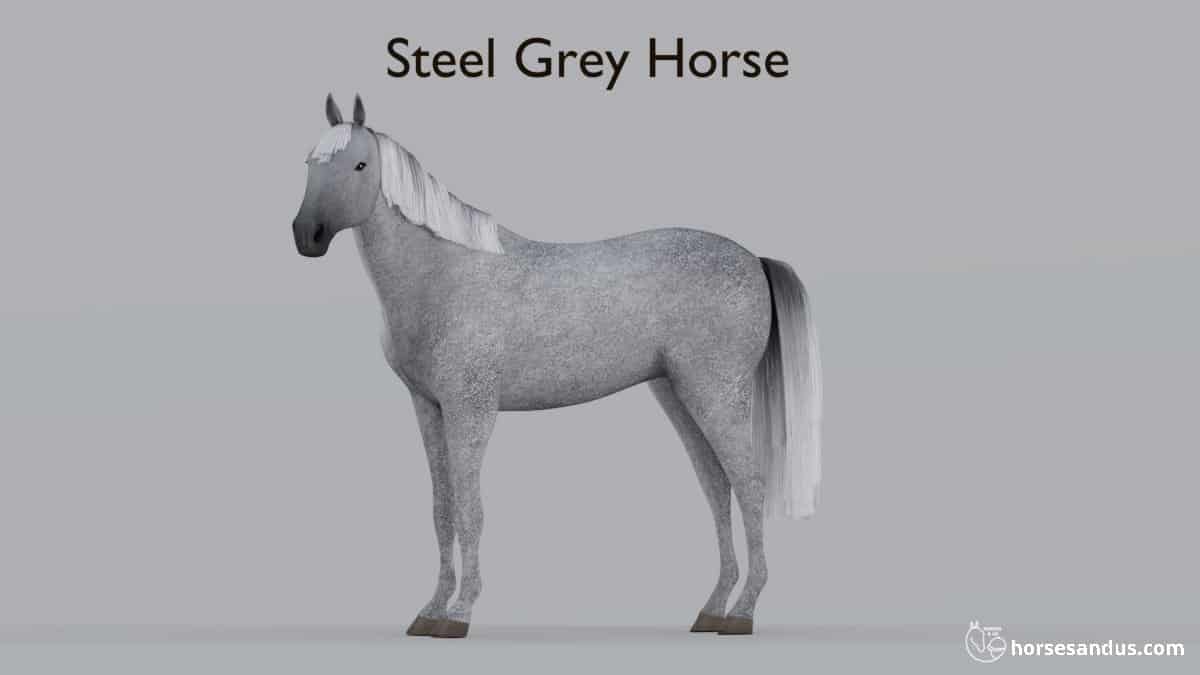
2. Rose Grey
A Rose Grey coat has a reddish tint.
This shade occurs in the early stage of the greying process and when a horse has a red (chestnut) or light bay base color coat.
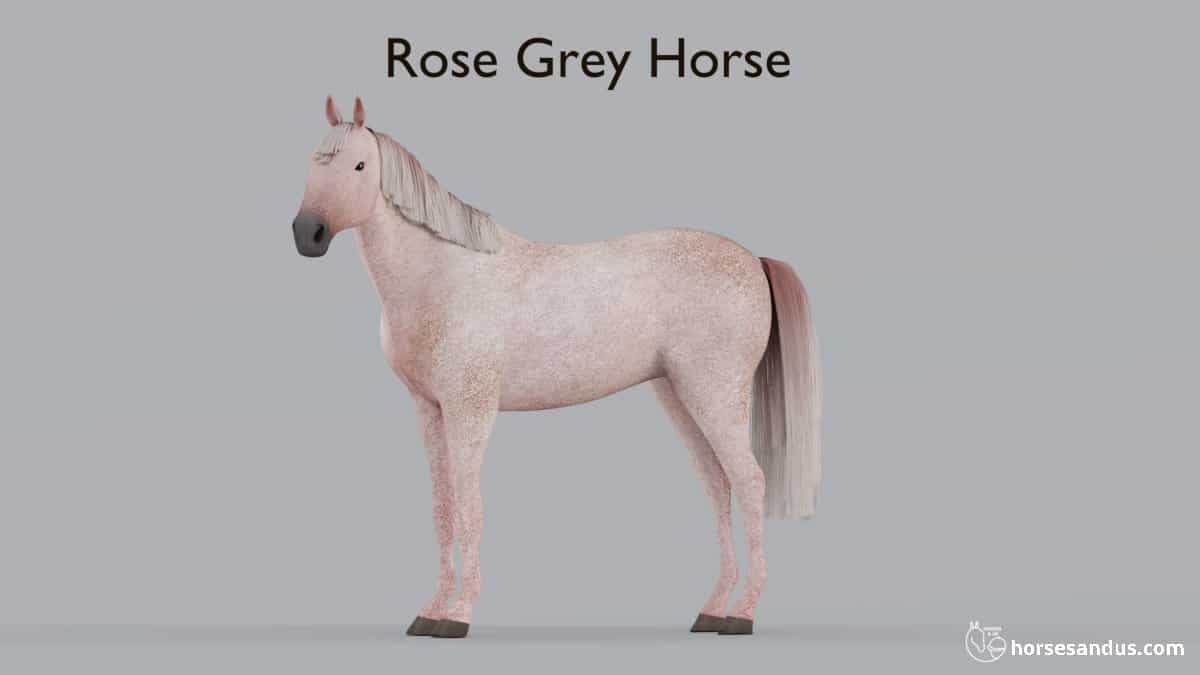
3. Dapple Grey
A Dapple Grey coat is very attractive and is characterized by light-colored circles or rings on a darker grey coat.
This pattern appears in the intermediate stage of the greying process in young adult horses of any base color.
Although it is a common pattern in grey horses, it does not always occur.
This dappling should not be confused with the dappling seen in horses that are in good physical condition.
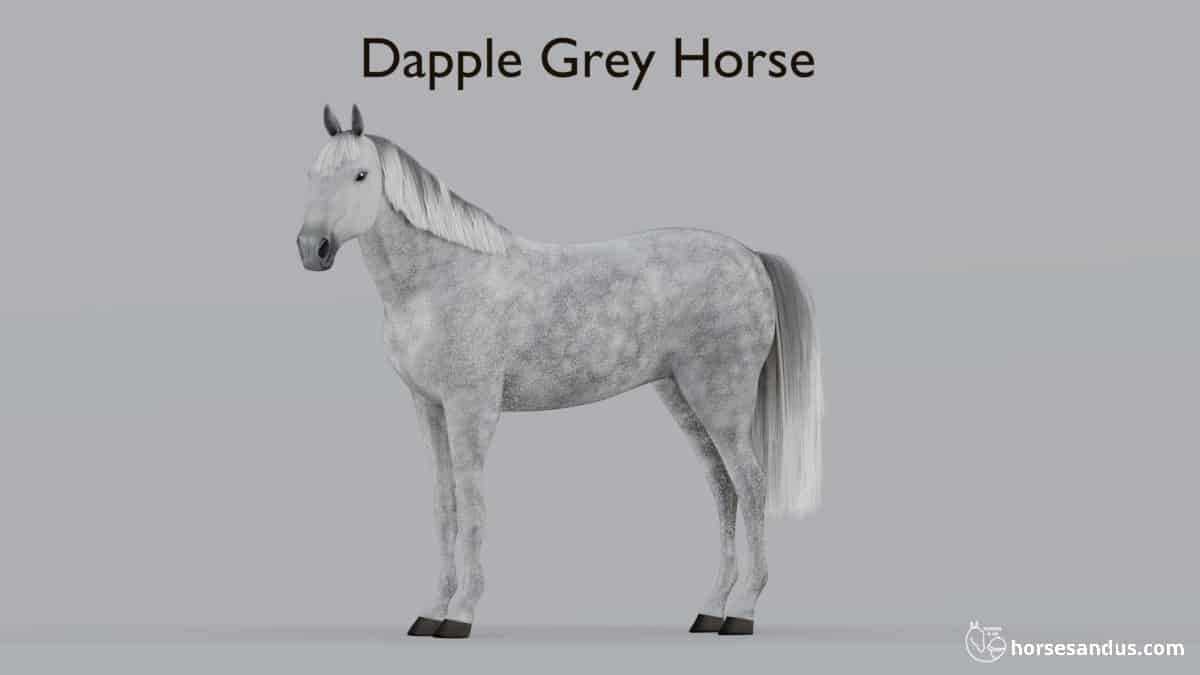
4. Pure White Grey
A Pure White Grey coat has all the body, mane, and tail hair completely depigmented. It is often confused with a True White Horse.
This pattern appears in the final stage of the greying process in a mature horse of any color.
Pure White horses

5. “Flea-bitten” Grey
A “Flea-bitten” Grey Coat has small pigmented speckles of the original base color scattered throughout the lighter coat. They look like freckles on a white coat.
This pattern appears in the final stage of the greying process and is caused by the re-pigmentation of previously depigmented hair.
This pattern is not very common and can vary from only a few speckles that are barely visible to many dense and large speckles throughout the coat.
The mechanism of acquiring these “Flea-bites” is still unknown. It is thought to be caused by another gene unrelated to the grey gene.
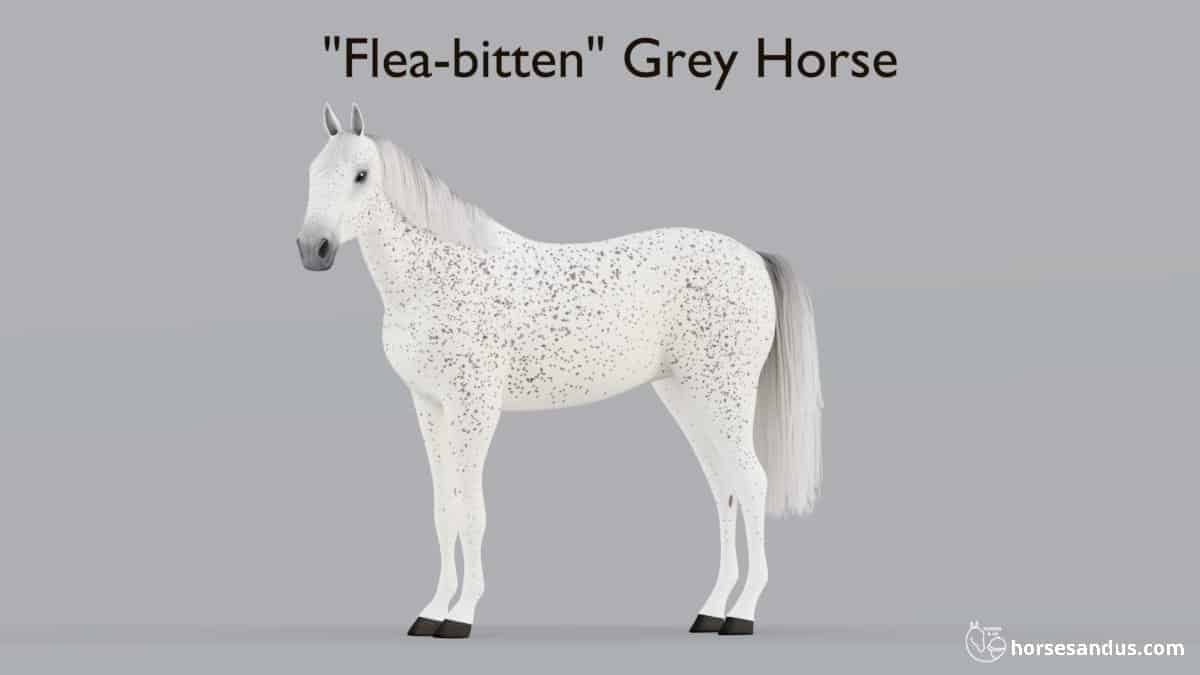
6. “Blood Marked” Grey
A Blood Marked Grey coat is characterized by large patches of pigmented red hair called “blood marks.”
These blood marks usually develop over the shoulders and, in this case, are called “bloody shouldered grey.”
These patches tend to enlarge as the horse ages, and in very rare cases, they can cover most of the body in old horses.
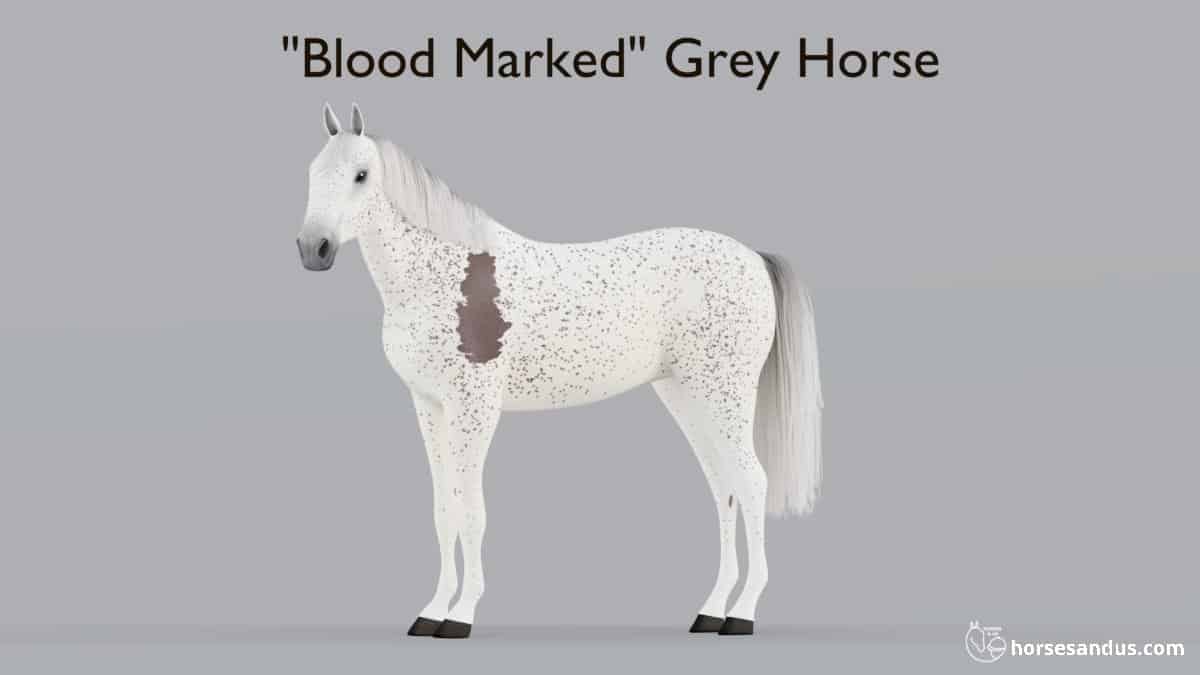
Similarities of Grey Horse with other Horse Colors
Grey horses can sometimes be confused with horses of other colors.
Grey Horses Versus White Horses
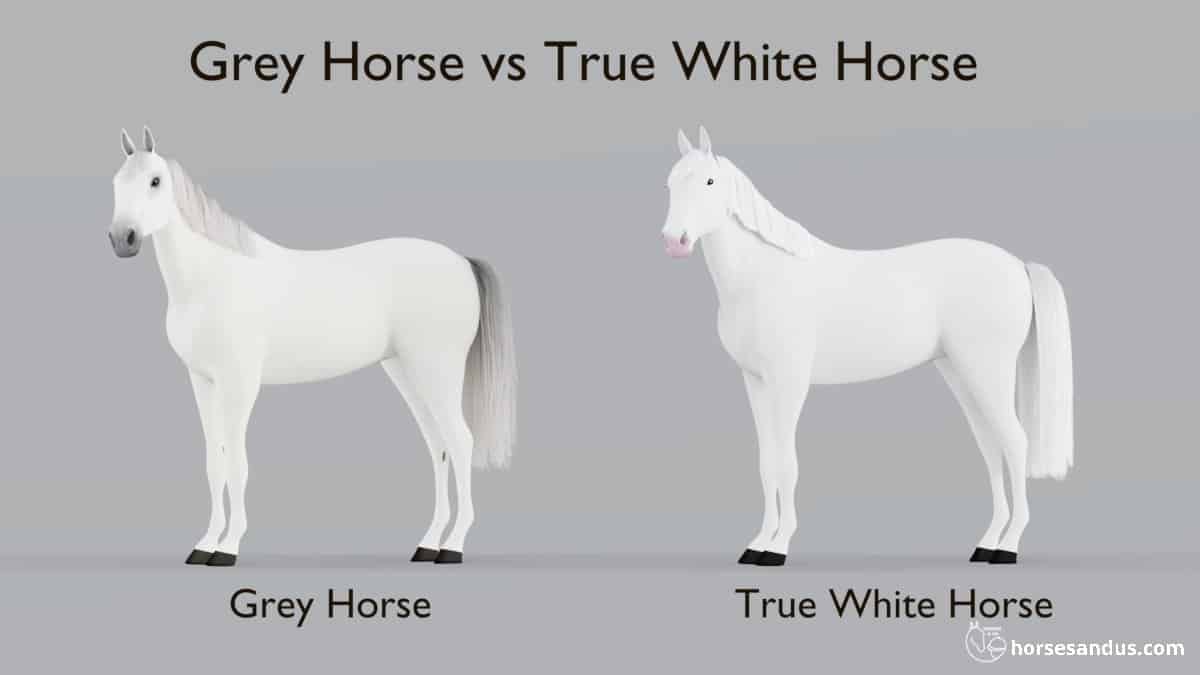
Completely White Grey Horses are often confused with True White Horses (which carry the dominant white gene). However, it is quite easy to differentiate them.
Unlike the pink skin of true white horses, grey horses will usually have dark skin. This dark skin is associated with the base coat color of the horse. The color of the underlying skin is usually only visible in the muzzle, around the eyes, and genital area.
Contrary to true white horses that are born white, Grey horses are born colored and progressively whiten as they grow older.
Grey Horses Versus Roan Horses

Grey Horses are often confused with Roan horses. The confusion is due to the similar intermixing of white and colored hairs.
However, Grey is not a white pattern like Roan. Instead, it is produced by a modifier gene that causes a progressive whitening of the horse´s hair throughout its lifetime.
A Grey horse can change from a completely colored foal to a completely white horse. Contrarily Roan horses keep the amount of white hairs stable during all the life of the horse. In some cases, Roan horses can even darken with age.
Another difference is that the head of the roan horses is typically colored, but in grey horses, it will have a similar intermix of hairs as the rest of the body. In Grey Horses, the progressive greying is made uniformly across the body and head.
Grey Horses Versus Grullo Horses
In some cases, Steel Grey horses with dark points (mane, tail, and lower legs) can be confused with Grullo Horses. The confusion is due to the similar shade of bluish-grey coat color.
However, this shade in the Grullo horse is due to the partial pigmentation of the individual hairs, while on the grey horses, it is due to the intermix of colored and white hairs.
The Grullo horse also has the primitive markings present, while a grey horse does not (unless it also carries the Dun gene).
How To Tell If a Foal is Grey?
If either or both of the foal’s parents are grey, then there is a possibility that the foal may also be grey.
Since foals are born colored, you will usually not know if it will be grey until after some time and when it starts to shed the first coat.
However, there are two tell-tale signs that can help you know in advance if it will become grey.
1. The Foal’s Coat is Very Dark
The foal’s coat, in particular the lower legs, is very dark or even black. This is because the Grey gene causes excessive pigmentation of the foal´s coat before decreasing pigmentation as the horse ages.
So if you look at the foal and the legs have a light color, it will most probably be colored. If the color is very dark, then there is a strong probability that it will be Grey.
2. The Foal Has White Hair Around the Eyes
The foal can have white rings of hair around the eyes (“eyeglasses” or “grey goggles”). The first white hairs will appear in the face, usually around the eyes. Even before the white rings are clearly visible, if you observe closely and see any white hair in this area, you will know that the foal will turn grey.
The Genes behind Grey horses
The greying process is due to the Grey gene represented by the symbol “G,” which is also used to represent the dominant allele. The recessive allele, absence of grey, is represented by the lowercase symbol “g.”
Grey is a modifier gene and acts as a switch. It is either “on” or “off”.
The switch is “on” when G is present (G/G or G/g), and is “off” whenever G is absent (g/g).
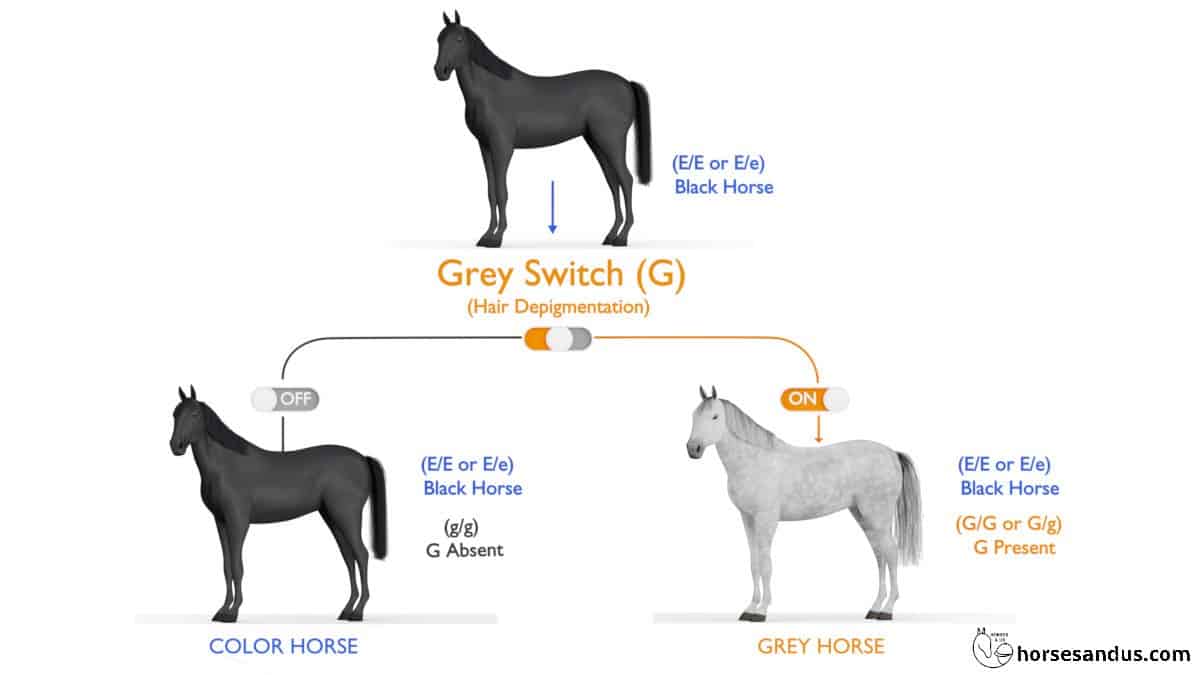
As G is dominant, only one copy of the allele is needed to produce a Grey horse. So Heterozygous and homozygous Greys have identical appearances. However,
- Homozygotes seem to grey faster than heterozygotes.
- Heterozygotes are more likely to develop “flea-bites” than homozygotes.
How the Grey Gene Acts on Hair Pigmentation
The Grey gene acts on the melanocytes located in the hair follicle, which are the cells that produce the pigment that gives the hair its color.
The gene first causes an increase in the number of melanocytes, which explains why the birth coat of grey foals is typically very dark.
As the horse ages, the Gene causes a gradual decrease of melanocytes in subsequent hair growth cycles until they completely disappear and the horse coat is pure white.
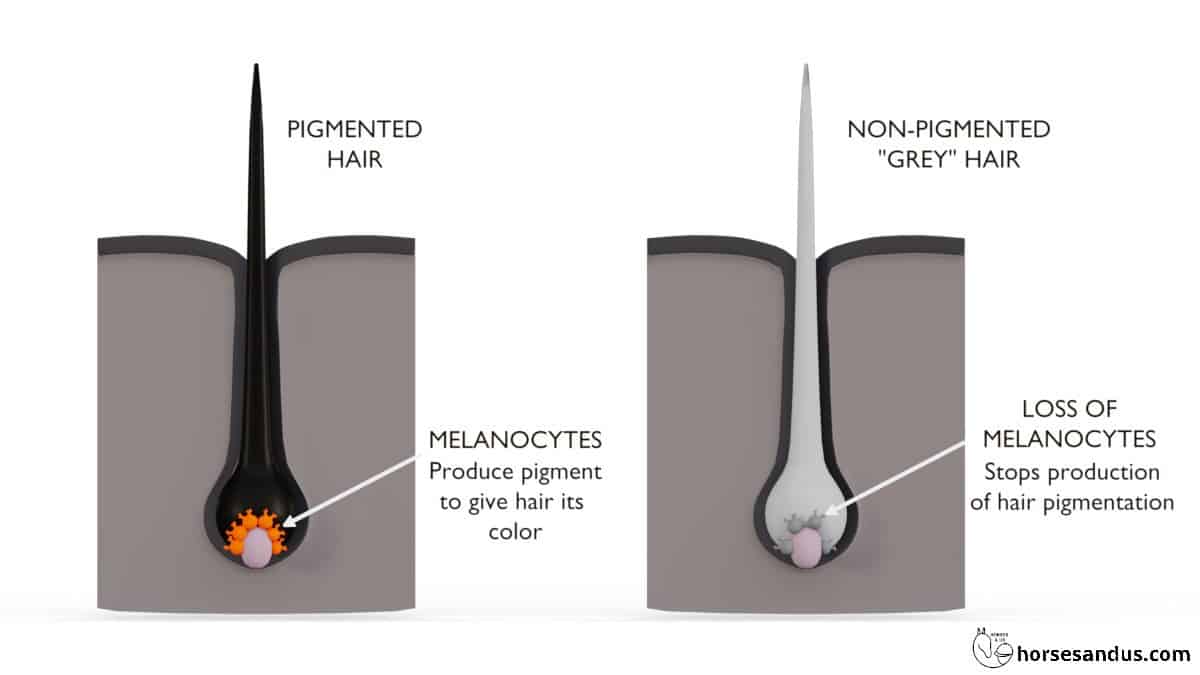
Grey Genes Inheritance
Since the Grey Gene is Dominant and cannot be hidden, we know that:
- a Grey foal must have at least one Grey parent
- two non-grey horses can never produce a Grey foal.
Using the following Punnett Squares we can see the possible offspring based on the parent´s different genotypes.
Health Issues Associated with Grey Horses
Grey horses have an increased risk of developing melanoma (skin cancer).
Melanoma in horses occurs most frequently underneath the tail, around the lips, and on the eyelids.
It is believed that about 70-80% of grey horses will develop melanoma after 15 years of age, and the incidence is higher in homozygotes.
There are 3 possible patterns of melanoma
- In most cases, the melanoma is benign and grows slowly over many years without any metastases.
- In some cases, benign melanoma suffers a malignant transformation.
- In rare cases, melanoma is malignant from the beginning.
Horse Breeds That Can Have the Grey Color
Grey is very common and exists in most horse breeds worldwide.
The breeds that do not have greys are typically those breeds with a specific color, such as Fjord, Friesian, Suffolk, Cleveland Bay, Haflinger, Appaloosa, American Paint Horse, etc.
In Lusitano, Andalusian, and Lipizzaner, grey is so common that other colors are a minority.
Famous Grey Horses
Most famous white horses are actually greys with hair coats turned to fully white.
Examples are:
- Marengo, the famous war horse of Napolean, was a grey Arabian Horse.
- Shadowfax, the horse ridden by Gandalf in the “Lord of the rings,” was portrayed by two grey horses of the Andalusian breed.
- Desert Orchid (Dessie) racehorse was a Thoroughbred grey horse.
Further Reading
If you would like to learn more about horse colors and white patterns, you may want to read the following books, available on amazon.
The links below that lead to products on Amazon are affiliate links and I earn a commission (with no additional cost for you) if you make a purchase.
The following books are an introduction to horse colors and white patterns which are full of images and very easy to understand.
The Equine Tapestry: An Introduction to Colors and Patterns The Ultimate Guide to Horse ColorsA more technical book about horse colors, but still very easy to understand.
Equine Color GeneticsSources
Behold The Pale Horse: The Genetics of Color and Cancer
Article from https://journals.plos.org
Article from colorgenetics.info
